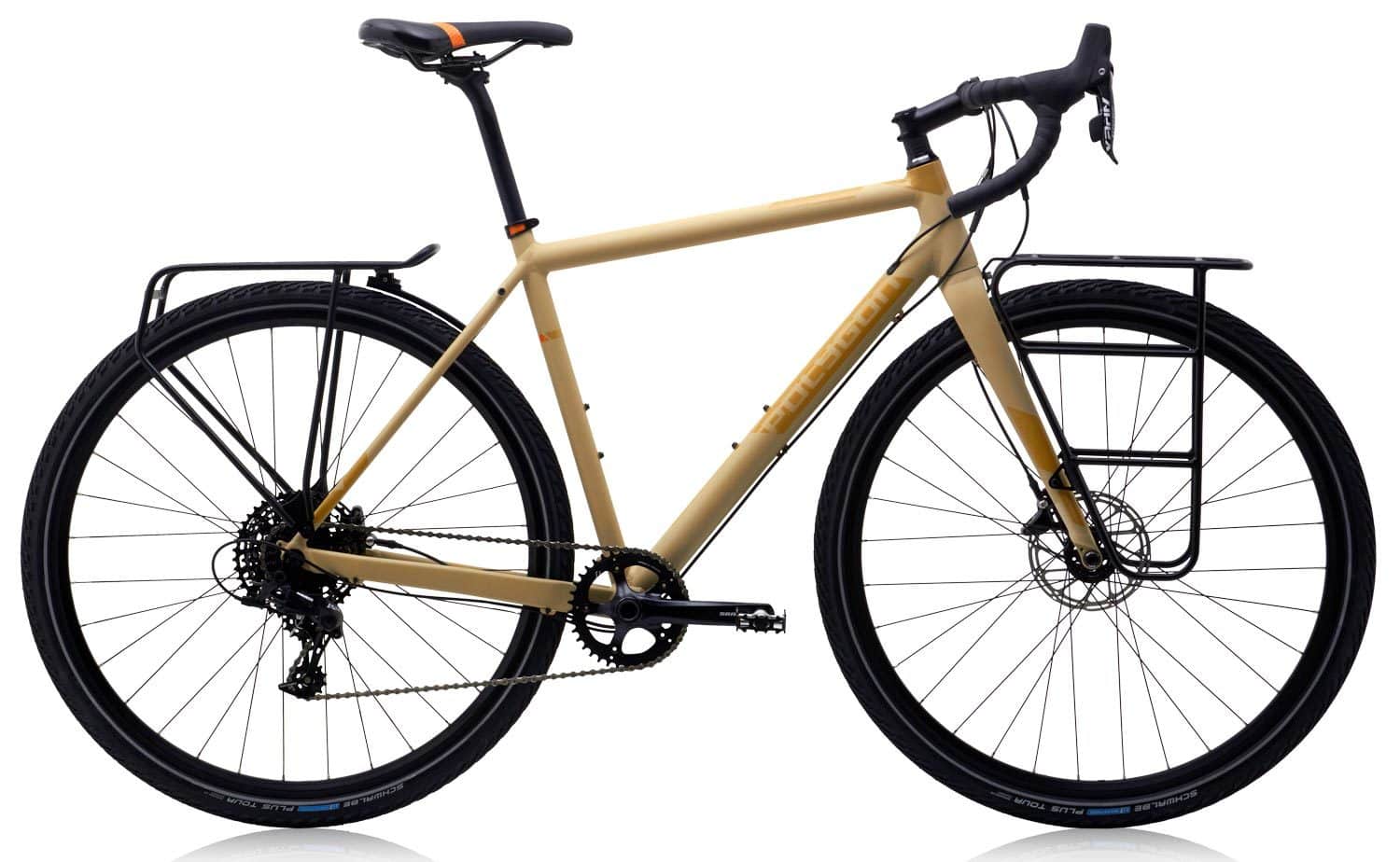Bicycle touring is one of the best ways to travel. The most important gear you should really think about is what bicycle you will be riding. If you want to do it the right way it is important to invest in the appropriate bicycle for your adventures.
We are going to discuss everything you should be looking for in a touring bike, to insure you have the best possible set of wheels to carry you through the most challenging bike tours.
We will cover things like what a touring bike is, and what bike you should buy, that is suited to your needs. Cover everything about frame materials, wheels and tyres, saddle, handlebars, gearing, pedals, and other accessories that make a great touring bicycle.
What Type Of Cycle Travel Do You Wish To Conduct?
To understand what type of touring bike you should get and what you should look for in a touring bike. First you must understand what type of bicycle touring you wish to conduct. There is a range of different styles, including:
Guided Touring
When you pay a bike tour company to ride with you in a group with other bike tourers. On a pre-planned route where there is often food and support given when needed. Generally during intervals throughout the day a van will meet up with the group offering food and bike maintenance. This type of travel includes planned accomodation where you stay each night.
Self-guided touring
Self-guide bicycle touring is very similar to the previous guided touring, that a bike tour company will plan out the routes and food and all other things for the tour. The difference is that you will be required to navigate the route on your own.
Self-supported touring
This is my kind of travel and is the much more popular type of bicycle touring amongst the community. You can travel solo or with someone else who also is carry all their own gear, You are completely independent and you must rely on your skills and knowledge to sustain your travels. Over many weeks, months or even years. You will need skills, to find food and water, to converse with people you meet on the road and plan your own routes. It is much less expensive in compression to the other forms of travel. As you are not paying for a company to do everything for you. You also get to go where ever you want, giving you total freedom.

There is also many other ways to travel by bicycle.
Bikepacking is another form of cycle travel that is getting more and more popular, as this allows you to travel with less gear that is attached to the frame of your bike. In the form of bike bags. This type of riding is generally on gravel, single track trails and mountainous terrain.
Credit card touring is the types of touring when you only pack a minimal amount of gear and you buy things as you go along on your tour. Often buying food in restaurants and sleeping in hotels.
There are many different ways to bicycle tour. There are also many different types of touring bicycles which have a particular style of bicycle touring in mind.
Ask yourself some of these questions.
- What style of bicycle tour do you wish to conduct?
- The length of time you will be on the road? One day long ride? Overnight trip? Week long tour? Or multiple months or even years?
- How much gear do you plan to carry with you on your bicycle tour?
- The type of roads or trails you expect to ride one? More off-road, wilderness style riding? Or more cycle paths, and on roads?
Different Types Of Touring Bicycles?
A touring bicycle is a bicycle that is designed to transport someone and all their gear for a extended period of time. Typically over many days, months or even years. Across countries and even around the world. This type of bike is made to offer comfort for the rider, while also being stable and strong.
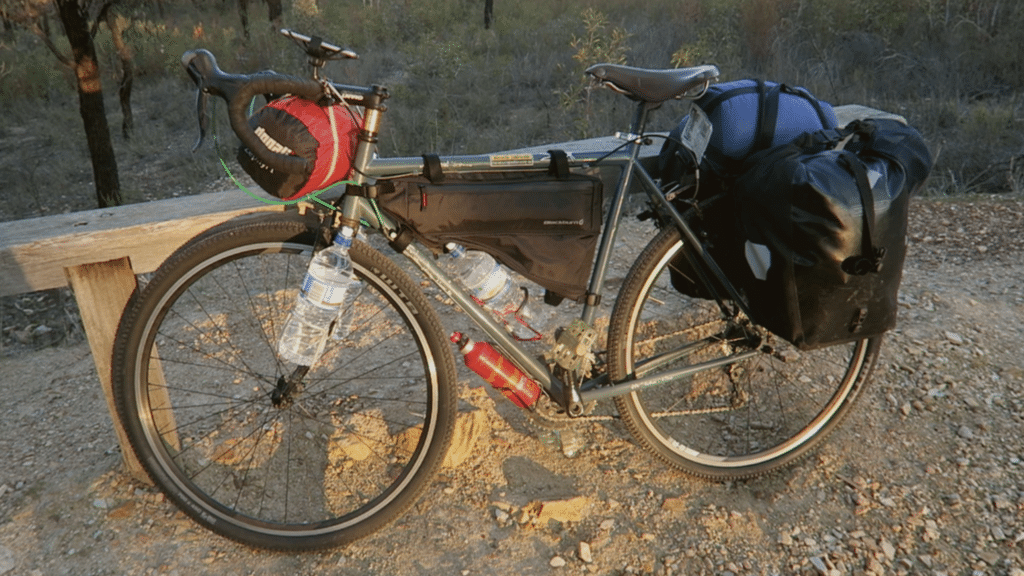
Commuter and Recreation Bicycles
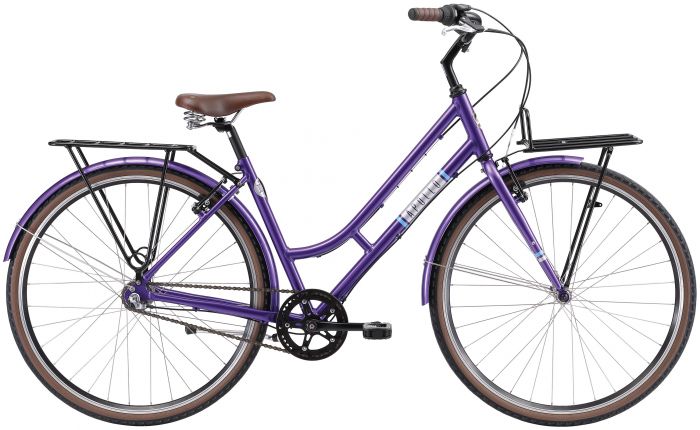
Are designed for short day trip types of riding. Best for riding to work or commuting to the grocery store. They often have a small range of gears. Which is not ideal for lengthy tours around the world or for travelling fast.
- They will often have wider, hybrid style tyres
- May include racks and fenders
- Have either, flat or drop handlebars
Sport Touring Bicycles
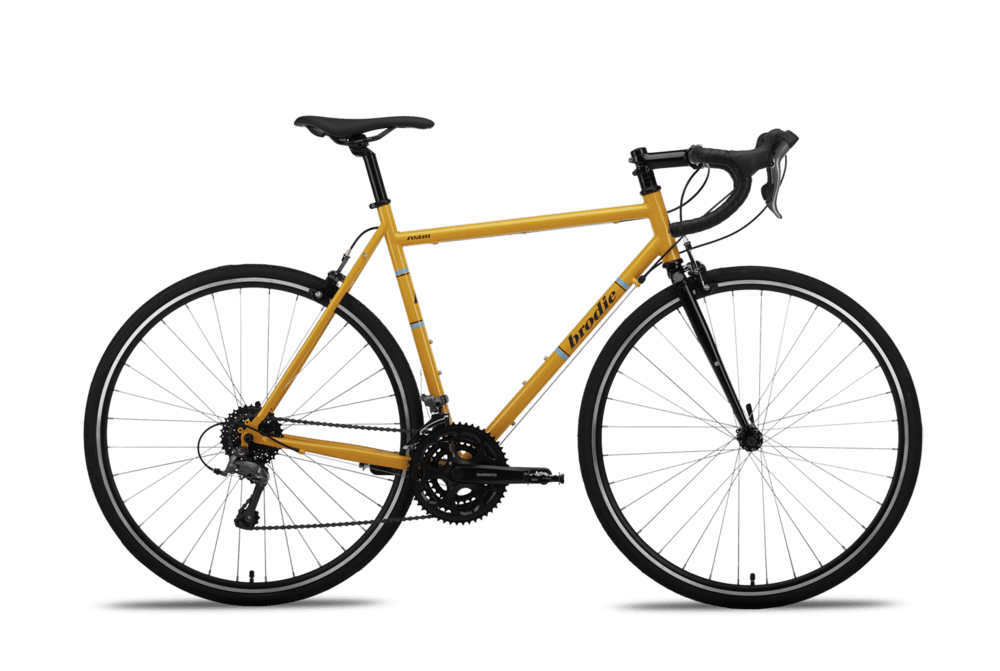
These type of bikes are designed with travelling fast in mind. They have a race frame geometry which help with speed. They have eyelets making these types of bikes best for credit card touring or other tours where you plan to travel with minimal gear and for a shorter duration, something like a week long tour.
- Have thin road tyres
- Most times only have 2 chin rings
- Race frame geometry
- Have drop bars
Light Touring Bicycles

These bikes often come with racks and fenders, also kick stands. Often frame material is aluminium. Always has flat handlebars. Hybrid style tyres. This type of bicycle is suited for no more then a 2 week bicycle tour. As it is not designed for extended month long tours and hauling heavy loads.
Road Touring Bicycles

As the name suggests these touring bikes are designed for mostly on road and cycle path touring. While they can ride on trails and off-road they are not made for that particular style of riding. These bikes are great for travelling across states and countries. Carry heavy loads, they have options for rear and front racks and panniers.
- Sometimes have up to 3 water bottle mounting points on the frame
- Wide gearing range
- Slightly wider tyres then road tyres
- Steel is the most common frame material
- Most of these bikes have drop bars.
Off-Road Touring Bicycles

These are the ultimate touring bike in my opinion. They can essentially do anything and go almost anywhere. They are designed for off road, single track, and trail style riding. But can also been ridden on roads and cycling paths. They have mounting for rear and front racks and panniers.
- Mountain bike gearing
- Come in a variety of different handlebar options
- Wider tyres, typically 26″ or 29″
Road touring and off-road touring bicycles are the best option for long self-supported bicycle tours over many weeks or months. Once again it depends on the type of terrain you want to ride more of, to which of these bikes you choose.
Other Specialised Touring Bicycles
These bicycles listed below are more specialised and are not the most common type of touring bike but still are used for a variety of different tours.
Fat Bikes or Fat Tire Touring Bicycles

These bikes are a total different pedigree. Fat bikes are different to other touring bikes as they have very wide and oversized tyres. Typically 3.8 in (97 mm) or larger and rims 2.16 in (55 mm) or wider. Made for riding in environments where it is not suitable for other bikes. Like on soft, unstable terrain, such as snow, sand, bogs and mud.
I will be getting one of these bikes eventually to ride The Canning Stock Route through Western Australia’s very sandy desserts.
Recumbent Touring Bikes and Trikes

Recumbent trikes are a more relaxed riding position. Some models allow for mounting rear racks and panniers. And can be used for around the world expeditions.
Folding Touring Bike

Folding Touring bicycles are best for when travelling and using public transport. As the utility for these bikes are folding up to almost nothing. These are capable of carry rear and front racks and panniers.
Special Features In A Touring Bike
Frame Materials
A quality touring bicycle frame is built for stability, comfortability and utility compared to being lightweight and made for speed.
These frames allow for more sensitive steering and offer a lower centre of gravity.
There are four main materials almost all touring bicycles are made from including:
Steel, Aluminium, Titanium and Platinum
Steel Frames
Steel frames are the most common material found in touring bicycles.
- Providing a strong and sturdy construction for holding very heavy loads.
- More heavy frame then other materials
- Flexible, providing comfort over long distances
- Easy to repair in most places around the world while touring
Aluminium Frames
Are not as common with touring bikes compared to steel, but are still sometimes used. This type of frame is less dense as it requires more aluminium for strength and structure. Often resulting in a more rigid and less comfortable ride.
- Lightweight
- Rustproof
- Responsive
- Affordable
- Uncomfortable and stiff construction, for long distances
Titanium Frames
Titanium is great material for touring frames. It is strong much like steel, it has a larger diameter compared to steel. The only downside to titanium is the cost. It is considerably more costly for entry level bike travellers.
- Expensive
- Lighter weight compared to steel
- Resistant to rust and corrosion
Platinum Frames
Platinum is a less common material used in touring bicycle frames. Not all of the frame is made form platinum it is often combined with steel.
- Very expensive
- Resistant to corrosion
- Very rare
- Very high end bikes are sometimes made from platinum
Steel frames are recommended when looking for the ideal touring bike. While it is great if you get Titanium and Platinum these are not preferred due to hoe expensive they are for most beginners. Aluminium is okay if you plan to cycle for up to a couple of weeks, but anything longer it will start to feel uncomfortable and is why steel is most preferred.
Touring Bicycle Wheels, Tubes and Tyres
Depending on the type of touring bike the wheels, tubes and tyres will be different. Most often a road touring bike uses 700c wheels while a off road touring bike uses wider 26 or 29 inch wheels and tyres.
700c Wheels
700c wheels and tyres are the most common amongst touring bikes. These wheels are build with the demands of bicycle touring in mind. In that they have more spokes then road racing wheels. 32 to 48 spokes is common with touring bikes, although 40 or more spokes is recommend. As the more spokes there is less load on the hub and more strength and rigidity for the expected load a touring bike has to carry. The rims are wider to allow for wider tyres.
These wheels are suited for travelling in more modern countries where they are often available if replacements are needed. Countries like North America, Europe, parts of Asia, Australia, New Zealand. And some other countries like Africa and South America don’t generally have 700c touring wheels suited for touring bicycles. Depending on where in the world you plan to tour, will also depend on the size of tyres and wheels you use on your touring bicycle.
650B Wheels
This size tyre and wheels are very similar in diameter to 600c wheels. The main difference is they are designed to fit wider tyres. Making them suitable for off road gravel bike touring setups. This size is often a newer size is is less common in some places in the world like south America and in Africa.
26″ Inch Wheels
These are the most common wheel and tyre size for off road touring bikes. If you are planning a bike tour anywhere in the world this size is most common, and you will have no problems finding this size. It can be used on off road and road terrains. Also you can let the tyre pressure down for more traction with off road trails without the fear of punctures. Making them slightly more comfortable to ride.
29″ Inch Wheels
These are growing in popularity due to the cyclocross and bikepacking style of riding. These are more suited primarily for off road trail riding. They are build for more durability and wider then your typical 700c wheels. If you plan to ride both on and off road a 650B size is more suitable. However, 29 Inch wheels will commonly have fatter tyres and are used mostly on bikepacking bikes which mostly ride off road.
Touring Bicycle Tyres
Clincher Tyres
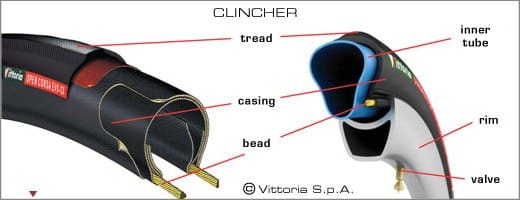
Clincher Tyres are the most common type of tyre that you will find on most road touring bicycles. As they are made up of a bead that hooks under the inside of the rim. With a casing material which makes up the main structure of the tyre. Followed by the rubber and tread which is what we see on the outside of the tyre. These tyres are inflated with a inner tube. And when punctures occur the inner tube is patched or replaced.
Tubeless Tyres
Tubeless tyres are mostly used on bikepacking and off road touring bikes. As they are wider tyres. They are more durable with potential punctures as they are not effect as much as clincher tyres.
Tyre Pressure
If you your bike is fully loaded it is recommended to have your tyres at a fairly high pressure. Too what is recommended on the outside wall of your tyre. If you are riding off road generally your tyre pressure will be lower.
Make sure not to run your tyre pressure to low. As this posses problems with pinch flats, tyre rolling of the rim, and expending too much energy then needed. But also insure that your tyre pressure is not too high, as this also is not good and will result in you potentially damaging the rim and flats.
Tread Patterns
On road tread patterns require no real tread at all. As the surface area of the tyre that touches the road is very little and it conforms to the shape of the road as it makes compact. So if you plan to only touring on roads, it is best to look for tyres that have no tread at all.
Off road tread patterns must have some kind of beefier tread for traction on varied terrains. The more tread the better for off road, bikepacking touring bikes.
If you plan to try both on and off road touring on your bike. It is recommended to get tyres that have almost not tread down the centre on the tyre where the most impact touches the road. And as the tyre moves outward there is more and more tread which helps when riding off road condition.
Tyre Tubes

There are two different types of tyre tubes, Schrader Valve and Presta Valve.
Presta Valve tubes are less common in those remote corners of the world and it may be a good idea to get a touring bike that is suited to the Schrader Valve tube.
Having that said the most common tube on most touring bikes is the Presta Valve. As these valves are skinner then Schrader Valves meaning that the hole that they make in the rim is smaller. This is the weakest part of the rim. Reason why touring bikes opt for Presta Valve tubes, due to the extra weight touring bikes carry it makes the rim that little bit stronger in comparison.
Touring Bicycle Handlebars
Touring bikes come in a range of different handle bars. The most common and popular are drop bars. You may also find flat bars and Butterfly or Trekking Bars. Handlebars that offer a range of different hand positions are ideal.
Drop Handlebars

Drop bars are most common on US style road touring bikes that are suited for long month and year long bike tours. As they provide many differ hand positions. Sometime I find that these bars are not the best for your back and your overall posture. Depending on how you have them setup.
Flat Handlebars

Flat handlebars are generally found on touring bike that are used for 1 to 2 week bike tours and generally no longer. As they only provide minimal different hand positions. If you have your hands in the same position for a extended period of time. It could possibly cause nerve damage. Which is why this handlebar is not suite for a tour that is longer then 2 weeks.
Butterfly Handlebars

These are my favourite handlebars at the moment. As they offer so many different hand positions. But also provide better bike position and posture. The Butterfly Handlebars (I share my experience with them here) are designed for touring in mind are great handlebars for long multi month or even year long bike tours.




Other Types Of Handlebars
Velo Orange Crazy Bars

Handlebar Brakes and Shifters
Depending on what style of handlebars your touring bike has, your brakes and shifters may differ.
Bar-End Shifters

These are commonly used on touring bikes with drop bars. Allowing you to shift gear when your hands are in the drop position. These shifters are easier to repair in more remote places in the world compared to Brake/End Combo Shifters which I will be talking about next.
Brake/End Combo Shifters

These shifters are also common on touring bike with drop bars. But this type combines both the gear shifter and brake all in one position. Which can be accessed at your finger tips. I prefer these shifters as the Bar-End Shifters for me seem to be a little annoying to have to change hand positions sometimes to change gears. However parts for these shifters are more difficult to repair in remote places in the world, depending on where you are touring.
The next two shifter I will mention below are more suited to either flat handlebars or butterfly/trekking handlebars. As the require different style of shifter compared to drop handlebars.
Thumb Shifters
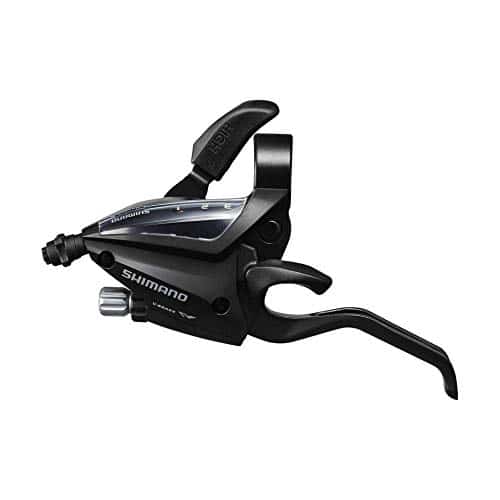
These shifters are the type I used on my butterfly bars. ($29.99 on Amazon) As they allow you to change up and down gears. These shifters are easier to repair. They are attached to the handlebar and can be removed.
Grip Shifters
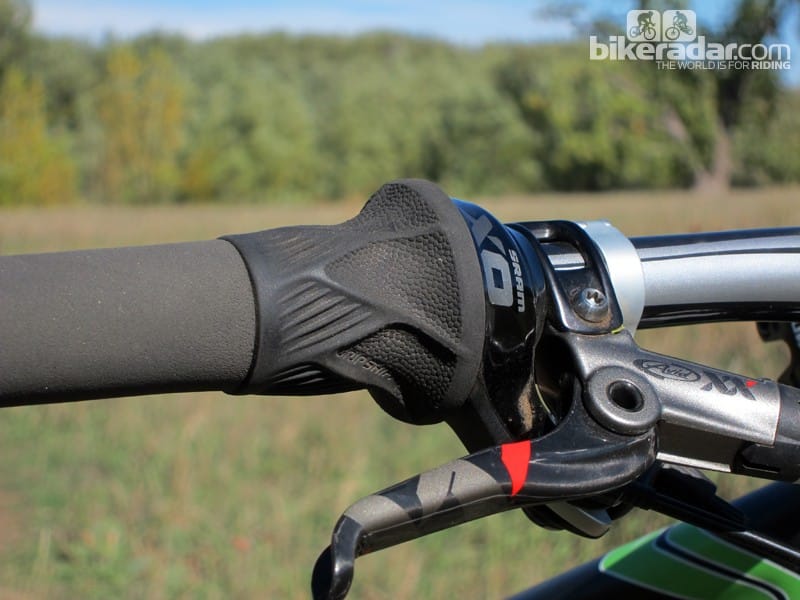
While grip shifters are designed to be integrated into the handlebars. Taking up less space on the bar for mounting accessories.
Touring Bicycle Saddles
A Saddle is one of the most important aspects of a touring bicycle. Your body weight is supported by the saddle, handlebars and pedals. Considering this is a significant contact point of the body to the bike. Touring bicycle saddles are much more comfortable then standard bike seats. Due to the length of time you will be sitting on your bike, sometimes more then 8 hours per day, this is a important aspect of a great touring bike.
You may experience some kind of pain on your bottom from riding everyday for long periods of time each day. It is important to understand that this is normal for bike touring. As it is not a completely pain free experience, it is going to be somewhat uncomfortable.
Butt and crotch pain can be caused by; clothing that does not fit properly or it continually rubs in the same spot as you consistently pedal. Excess body fat which may also rub and cause irritation. Or a incorrect fitting on your bike. You may have misalignment issues with your handlebar and seat hight
Lycra is your friend
try buying yourself a pair of lyrca cycling shorts. they have no seems to cause irritation. and make for a more enjoyable and comfortable ride. they will also conform any excess body fat.
Things to look for in a good touring saddle
- Firm at its core
- Has some padding but not a lot. You don’t really want a over padded saddle. As this could cause more discomfort.
- Has some flexibility
- Has no seams on the contact point to your body.
Racks And Panniers
The most popular way to carry all your gear on a bicycle tour is with racks with pannier bags attached. Often front and rear setups. Panniers are relatively easy to pack and access throughout a riding day.
Waterproof panniers
A important thing to look out for when purchasing panniers is waterproofing capabilities. In my opinion it is important to opt for waterproof panniers. Otherwise you gear will most likely get wet. Unless you use a rain cover. But for the guarantee waterproof panniers with a roll top lid are ideal.
Rack Recommendations
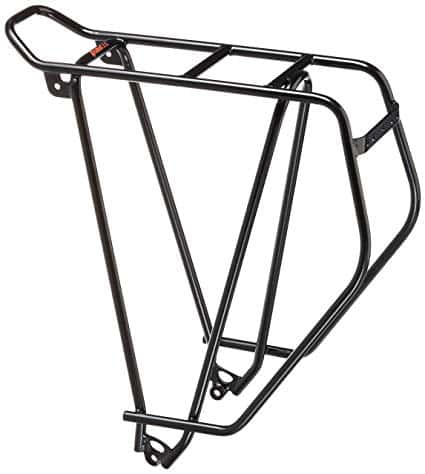
Tubus Cargo Evo Classic Rear Rack 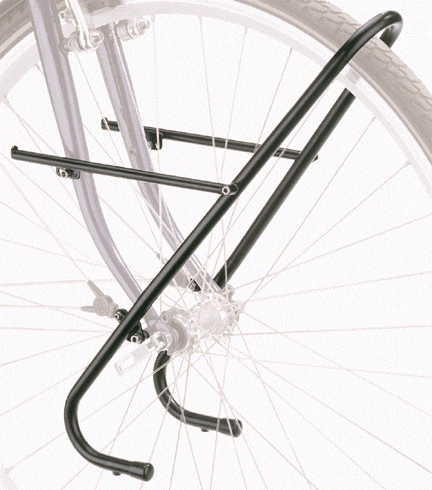
Lowrider Tara Front Rack
Pannier Recommendations

Ortlieb Back-Roller Classic Rear Panniers 
Ortlieb Sport-Roller Classic Front Panniers
Want to learn more about how to put panniers on a road bike? I wrote a article here
Shoes and Pedals
There are two main types of pedals that are commonly used for bicycle touring. it is more of a persona preference which one you would like to get for your touring bike. However they both have advantages and disadvantages.
Flat Pedals
Flat pedals are the type of pedals I prefer to use. You don’t need to clip in to the pedal which can be tricky to learn when you are first bicycle touring as the heavy bike can be cumbersome.
This is a more casual cycling style, you can ride in thongs if you wish. Or normal sneakers and not have to carry multiple pairs of shoes.
Also flat pedals are inexpensive.
SPD / Clip-In Pedals
These pedals are great as the provide efficiency when pedalling on the down and up as the pedal is attached to your shoe you get better use of your energy while cycling.
The shoes required for these pedals are somewhat uncomfortable after walking a considerable distance in them.
But act as a multipurpose shoes.
Best Shoes For Your Next Cycling Adventure
Gears And Brakes
With the huge variety of different touring bicycles out there. There is many types of gear combinations and brakes that we will talk a little about.
Most common gear combinations on touring bikes today
With gears from anywhere between, 18 to 27 gears. Most touring bike gearing is very similar to MTB gearing. As both are designed for riding up steep hills. As a touring bike is carry heavy loads it need a larger gearing range to make such riding conditions easier.
Amount of Chainrings
Are referred to in a set of numbers like for example this Surly LHT.
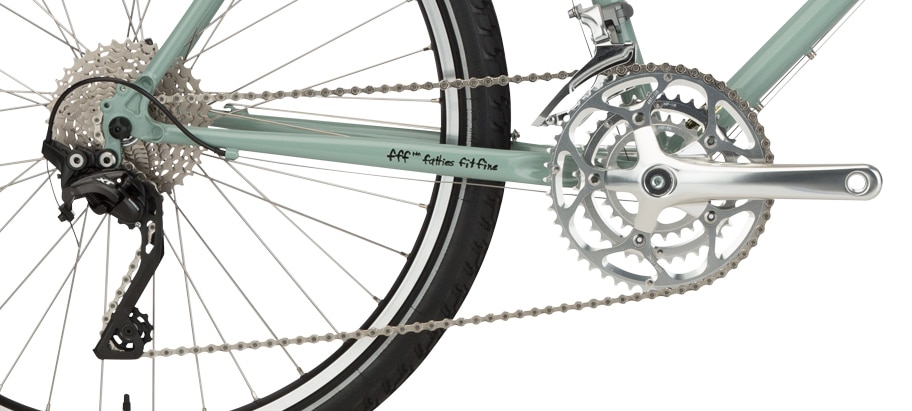

50 X 39 X 30 means the amount of teeth on each crank. The crank with the lowest teeth is the one used for riding up hills. And the biggest one for riding down hills or maintaining speed on flats.
When looking for a touring bike it is important to take note of the smallest number you see in the crankset combination. The ideal range for the lowest is around 22 to 30. This is going to be best for bicycle touring when riding up hills on a fully loaded bike. Anything more is typically not recommended.
Internal Gearing Systems
Pinion Gear Box or Roll Off Hub..
These are becoming more popular, you don’t need to worry much about these type of gearing systems in terms of maintenance like you would with a more traditional gearing system
The disadvantages to these systems is that they are expensive and heavier.
Brakes
Rim Brakes
- Much less expensive
- Lightweight
- Mechanically simple
- Easy to maintain
However the brake pads will wear down over time and will need to be replaced. The wear can cause the rim to potentially fail if the surface gets worn down significantly. But they can be found in many places around the world. These brakes do not perform the best in wet weather.
Disc Brakes
- Are much more expensive
- More difficult to maintain
- More complex
These types of brakes could be difficult to repair on the road in remote areas of the world. Stronger braking capability.
Other Touring Bicycle Traits To Look Out For
- Built from materials and parts that are easily found in many different areas all around the world.
- Offers a long wheel based geometry. Which makes the ride more comfortable when carry a heavy load. The longer distance from your legs pedalling means you don’t hit the gear which is mounted on your bike.

- Many mounting points, to carry front and rear racks
- Which also give to ability to carry up to 4 panniers (2 at the front and 2 at rear)
- Heavy duty and high quality front forks and wheels.
- Range of gears, specifically lower gears allowing you to ride up steep grades on the fully loaded bike with more ease.
How To Buy Your Ideal Touring Bicycle
- Decide which type of bicycle touring you wish to take part in most
- Most bicycles you are unable to buy directly from the manufacturer
- You will have to find a local dealer in your area. Search something like “Surly LHT Dealer Melbourne Australia”
- It is the best way to shop for a bike in my opinion as you can get fitted and make sure the bike is suited for your body size.
- Either ride a test bike or take your measurements is something you might think about doing before you head to the dealer to look at your new bike.
- Some bike shops don’t know a whole lot about touring bicycles. And they might try and sell you a bike that is not suitable for touring if they don’t stock touring bikes. So watch out for that.
- Try and avoid the spring time order frenzy with all bicycle touring bikes and gear. This is the typical time when everyone interested in touring bikes orders, and everything may well be out of stock. So your best best bet is to order your bike and the gear you need in advanced. Something like 3 to 6 months. Sometimes it takes up to three months just to get a bike ordered and sent by some touring bike companies.
- Or if you want to save a lot of money on your purchase. If you do it right you can pick up a great condition USED bicycle on places like eBay, Gumtree, Craigslist or other used ecommerce marketplaces. For a fraction of the retail price.
What is the difference between a road bike and a touring bike?
If you have ever asked this question and are curious to know the difference between the two I wrote a blog post explaining HERE.
Can I use a road bike for touring?
Yes you can, read more HERE about how you can put panniers on your road bike. This is a great idea if you don’t want to go out a buy a touring bike right away, and instead see if it is right for you.
